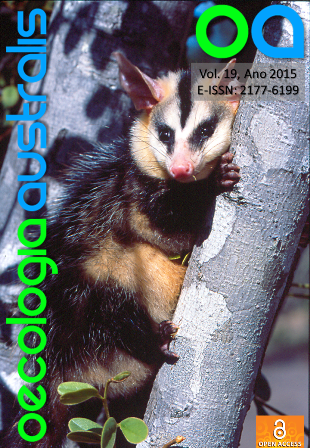Changes in food resource and bat abundance in banana plantations
DOI:
https://doi.org/10.4257/oeco.2015.1901.16Keywords:
Chiroptera, frugivorous, Musa paradisiaca, nectarivorous, richnessAbstract
Foraging patterns and diet of different species can change during the year in relation to food resources availability, which can influence abundance and richness of organisms. The greater the abundance of a particular food resource, we expect greater abundance of species that feed on it, and the greater the diversity of food resources, we expect higher species richness. Fruit crops can attract frugivorous and nectarivorous that feed on these plants. In banana plantations it was found greater abundance of frugivorous and nectarivorous bats than in forest fragments. The aim of this study was to determine whether the abundance of food resources influences the abundance and richness of bats, and particularly frugivorous and nectarivorous guilds, in banana plantation areas. Twelve banana plantations were selected in the southwest of Rio de Janeiro State. Each area was sampled twice, at an interval which varied from five to seven months. Bat sampling was performed using mist nets opened all night and food resource was estimated using plots, in which the number of banana trees and inflorescences of banana were recorded. We obtained 1,606 captures of 22 bat species. The abundance of Glossophaga soricina, a nectarivorous species, and of all nectarivorous bats, as well as the abundance of the frugivorous species Artibeus lituratus and of all frugivorous bats, were positively related to food resources abundance. Bat richness in turn did not show this relationship. These results indicate that the amount of food available in these plantations influences their use by bats. Despite bat feeding preference for certain families of plants, these interactions are not unique and they are able to adapt to other foods source. This result further supports the hypothesis that resources diversity is more important to keep higher diversity of bats than high abundance of a single resource.Downloads
Download data is not yet available.
Downloads
Additional Files
- camiladebarros, Cover letter OA.jpg (Português (Brasil))
- camiladebarros, Figura1.jpg (Português (Brasil))
- camiladebarros, Figura2A.jpg (Português (Brasil))
- camiladebarros, Figura2B.jpg (Português (Brasil))
- camiladebarros, Figura3A.jpg (Português (Brasil))
- camiladebarros, Figura3B.jpg (Português (Brasil))
- camiladebarros, Figura4A.jpg (Português (Brasil))
- camiladebarros, Figura4B.jpg (Português (Brasil))
- camiladebarros, Figura5A.jpg (Português (Brasil))
- camiladebarros, Figura5B.jpg (Português (Brasil))
- camiladebarros, Prezados Editores mod Nat.docx (Português (Brasil))
Published
2017-02-23
Issue
Section
Articles


